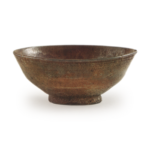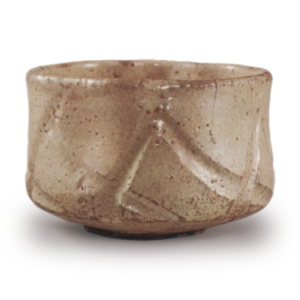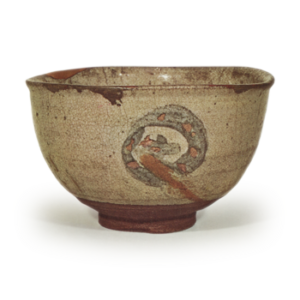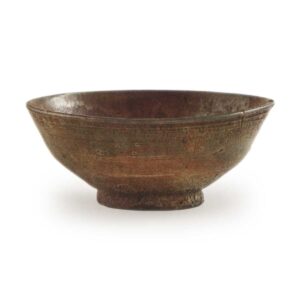
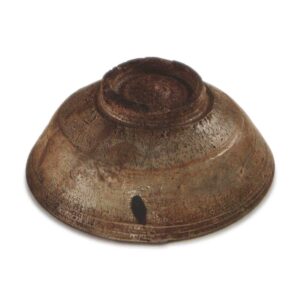
Held in the Hatakeyama Memorial Museum
Height: 5.1-5.4cm
Diameter: 21.7-13.1cm
Outer diameter of foot: 5.3-35.5cm
Height: 0.9cm
This is a small, tightly-made tea bowl, and it is named Hayato because of its nimble and agile appearance. There is another famous tea bowl called Kotaka (listed in the Taisho Meiki Kan), and it is said that these two bowls were in Kanazawa at the same time in the Meiji era, and that they competed with each other for fame, and were popular among the tea people of Kaga.
The clay is a coarse clay with a little iron content, and the shape is neat and clear, small and well-rounded, and yet also bold. The foot ring is particularly impressive, with a whorl of spirals that circles around the center of the helmet-shaped ring inside the foot ring, a groove that has been clearly and sharply carved out around the edge of the foot ring, and a rough, hard texture inside and outside the foot ring, with fine creases of various sizes. This is probably the main attraction of this tea bowl. The foot of the bowl is wide and the surface of the bowl has been cut down to clearly separate the waist and body of the bowl. From this line, the top of the bowl naturally and freely widens out, and near the rim of the bowl, there are two or three white lines that are the marks left by the potter’s wheel. This is because when the clay is being watered, some of the clay soil dissolves in the water and becomes muddy. This then sticks to the clay and runs against the potter’s wheel. There is also a small bevel on the rim.
On the inside, there is a clear ring-shaped mark around the waist, which is probably the mark of the stand called “shitta”. This is thought to be a mark left behind from the potter’s efforts to press down hard on the foot ring during the foot ring trimming process. In addition, there are two small spiral marks in the center of the bottom, as well as six black marks left behind from the potter’s wheel and two marks left behind from pebbles.
While the wheel-throwing is generally monotonous, the coloration is complex and subtle, both inside and out, and rich in variety. As usual, the glaze is thin, and the coloration is almost entirely due to the coloring of the clay body, as is usual with pottery. The color changes from a pale yellowish-white to a grayish-yellow called “kuchiba-iro”, to a slightly reddish yellow to a slightly dark reddish brown, and in between there are patches of bluish grayish-white and small spots of reddish brown. There is also a dark iron black spot near the rim on the outside. This is a coincidence, but it also makes for an effective scene.
On the inside, the glaze drips thinly near the rim, and only the part beyond that is a whitish lead color. This is also a striking sight. Despite its small size, it is a tea bowl with many highlights.
According to the notes, it was originally owned by Matsushiro Suo, or Matsudaira Suemori, but this is probably referring to Matsudaira Yasunao, the lord of the Kishu-Izumi domain. Yasunao was active as a foreign affairs magistrate at the end of the Edo period, and is famous for having successfully negotiated the border dispute with Russia over Sakhalin. After the Meiji Restoration, he resumed his former surname of Matsui and was granted the title of viscount. In 1878, this viscount Matsui transferred ownership of the tea caddy to the famous tea utensil maker Murahiko of Kanazawa, who was renowned at the time for his skill in making tea utensils.
The attached bag is made of Arisugawa silk. On the paper attached to the inside of the box lid, there is a note that says “This container was named ‘Haya Fusa’ when it was first made, but later it was used as a tea lunch box and the original box was thrown away. The outside of the box is painted red. On the paper pasted to the inside of the lid, the right-hand side of the note written by Kobori Masayuki is copied, and it is written in kirana, “Formerly owned by Matsudaira Shigenori. At the time, it was in Tokyo’s Magome area. In the autumn of the 11th year of Meiji, it was brought down from Higashi Kyu Akiyama Yosuke, and it is the best in Japan. There is black spotting on the outside, and it is closed. Murahiko”.

